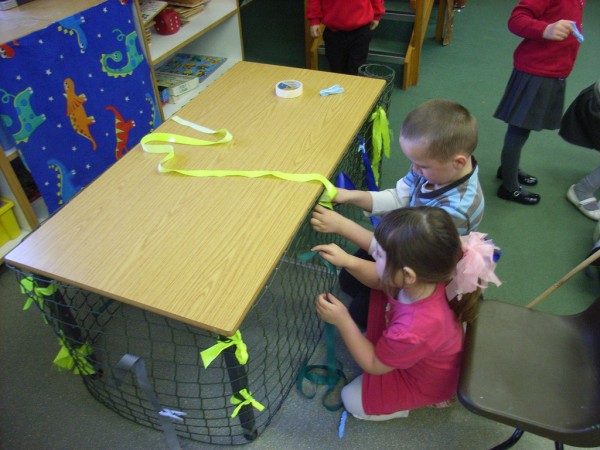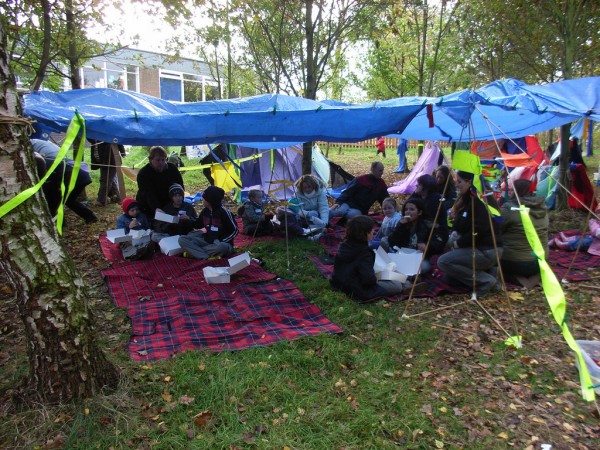Why Dens?
Young children love dens, in fact most people love dens. I’ve been making dens with people of all ages for many years, but mostly with children within early years, and there is a common phenomenon. As soon as the framework has been made there is always a rush of excited children to sit ‘inside’. And as soon as the frame is covered the excitement and activity level increases by several notches. What’s happening to produce this same effect with dens and young children time and again?
I started out in my creative career as a theatre designer before following my love of participatory work into community arts, which in turn took me into early years art. At first I was working with children to create environments from a whole range of mainly recycled materials. This included pegging fabric onto lengths of rope, drawn from my own childhood play, and skills honed as a worker on several arts based playschemes.
Amongst the materials were a few canes, and one day there was a eureka moment when we started pegging fabric onto the canes. For a young inquisitive mind, the combination of cane, peg and fabric is the great enabler and creative stimulator. They really are made for each other. I started to simplify the structures into the easily accessible basic blocks with which children could build both their own and group dens. The cane triangle was and still is this unit from which so many wonderful structures can be created. Den making to encourage imaginative play soon became the major part of my arts activities.
Whilst preparing for one of the regular training workshops I deliver, I reflected that one of the most appealing features of a den is that in it you can pretend to be anyone or anything and go anywhere or do anything. And this is what I had been doing all those years earlier as a theatre designer – simply creating environments and costumes in which the actors and audience could jointly enter into a world of make believe for the duration of the performance. My career had come full circle!
So let's return to that question of why the den is so stimulating for the developing early years' mind. Dens afford excitement within a safe environment. This love of the secure and personal space continues as we grow. Most of us when children, have enjoyed reading by torchlight under the covers in bed, not just because we shouldn't have been, but because it was our very own totally private and exciting space as well.
Later we've enjoyed pulling a quilt over ourselves on the settee and snuggling into another kind of den. There is perhaps something very basic about the sensory emotions that are triggered in our enjoyment of these intimate spaces. I have heard suggestions that it could almost be womb-like. Babies and toddlers love hide and seek played with any appropriate covering.
However, there are obviously clear boundaries between the thrill of a safe enclosure and the fear of being trapped within one, even using the same materials. I think that a significant difference is for the child to know that they are in control of the space, whether this is subconscious or not. When that control is extended into making the den another dimension of stimulation is added.
Let's consider some technical aspects of a den. There are ready-mades and built. The simplest ready made is perhaps the cardboard box, the bigger the better. Just on their own they are great fun. But of course they can also be customised in all sorts of wonderful ways, often requiring lots of adult help with stanley knives but affording plenty of opportunities for toddler led embellishments. Sooner or later they all collapse from sheer exuberant use. The simplest built dens are perhaps a sheet or large towel draped over a table, chair or bunk bed. These too may require adult help in securing the sheets but have the advantage of being reusable.
Key to the success of any den is that it stays up. This may seem blindingly obvious, but very often they frustratingly collapse or get blown over before the child or children have had an opportunity to use them and enter the exciting world of make believe. Making frames for dens from canes changes this. The techniques that I and others have developed require a mix of 'making with' and 'making for' on the part of the adult with the children, and the sensitivity to afford the child maximum control in the activity.
This blog is not meant to be a technical resume but I would recommend pre-making the basic building blocks of the 3ft and 4ft cane triangles fastened with cable ties. This not only enables the child to be in control of proceedings at an earlier stage, but means that these triangles can easily be reused. Additional canes are joined together using masking tape.
Children from age two have all done this with varying degrees of assistance and importantly a huge sense of achievement. As the reel of masking tape is passed between two 'taping' children they are not only increasing their technical and mathematical knowledge but also developing important co-operative and personal skills.
And it is fun. This cannot be stressed enough. There are many three dimensional shapes that can be made with the canes, but a prism (tent) and pyramids are two of the main ones. These can then joined together with more canes to make larger dens.
Inside a setting or house, upright canes can be taped to chair legs to make secure bases for joining horizontal canes that can be the frame for a den. Outside, the frames can be attached to fences or trees. Once the frames are made, the fabric 'sheets' and or ribbons can be pegged on to them. This process is in itself good fun and develops further motor skills. Throughout all of this building, a crucial role for the adult is to ask the children those questions that will help them to create an imaginary world with their dens.
Den making is great fun and develops many valuable skills, but it is only a means to developing imaginative play, which is perhaps the even bigger goal and prize. I do believe that the more children are creating their own dens and worlds, the easier it is for them to make up stories and develop many other aspects of their creativity. I am constantly amazed at just how much those canes do enable!
Graham Marsden is a Den Maker and Community Artist
Photo Credits: Graham Marsden





